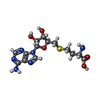+ Open data
Open data
- Basic information
Basic information
| Entry | Database: EMDB / ID: EMD-0695 | |||||||||
|---|---|---|---|---|---|---|---|---|---|---|
| Title | Cryo-EM structure of human MLL1-NCP complex, binding mode2 | |||||||||
 Map data Map data | Main map of human MLL1-NCP complex, binding mode2 | |||||||||
 Sample Sample |
| |||||||||
 Keywords Keywords | histone modification / nucleosome / MLL / TRANSCRIPTION / TRANSCRIPTION-DNA complex | |||||||||
| Function / homology |  Function and homology information Function and homology informationnegative regulation of DNA methylation-dependent heterochromatin formation / protein-cysteine methyltransferase activity / [histone H3]-lysine4 N-methyltransferase / histone H3K4 monomethyltransferase activity / response to potassium ion / unmethylated CpG binding / histone H3K4 trimethyltransferase activity / histone H3Q5ser reader activity / histone H3K4me1 reader activity / Epigenetic regulation of gene expression by MLL3 and MLL4 complexes ...negative regulation of DNA methylation-dependent heterochromatin formation / protein-cysteine methyltransferase activity / [histone H3]-lysine4 N-methyltransferase / histone H3K4 monomethyltransferase activity / response to potassium ion / unmethylated CpG binding / histone H3K4 trimethyltransferase activity / histone H3Q5ser reader activity / histone H3K4me1 reader activity / Epigenetic regulation of gene expression by MLL3 and MLL4 complexes / MLL3/4 complex / Set1C/COMPASS complex / MLL1/2 complex / definitive hemopoiesis / ATAC complex / regulation of short-term neuronal synaptic plasticity / NSL complex / histone H3K4 methyltransferase activity / Cardiogenesis / anterior/posterior pattern specification / T-helper 2 cell differentiation / embryonic hemopoiesis / Formation of WDR5-containing histone-modifying complexes / exploration behavior / minor groove of adenine-thymine-rich DNA binding / histone methyltransferase complex / hemopoiesis / MLL1 complex / regulation of embryonic development / regulation of cell division / histone acetyltransferase complex / membrane depolarization / cellular response to transforming growth factor beta stimulus / negative regulation of fibroblast proliferation / spleen development / positive regulation of gluconeogenesis / transcription initiation-coupled chromatin remodeling / homeostasis of number of cells within a tissue / Transferases; Transferring one-carbon groups; Methyltransferases / gluconeogenesis / post-embryonic development / skeletal system development / circadian regulation of gene expression / Deactivation of the beta-catenin transactivating complex / Formation of the beta-catenin:TCF transactivating complex / RUNX1 regulates genes involved in megakaryocyte differentiation and platelet function / beta-catenin binding / visual learning / protein modification process / PKMTs methylate histone lysines / response to estrogen / Activation of anterior HOX genes in hindbrain development during early embryogenesis / RMTs methylate histone arginines / Transcriptional regulation of granulopoiesis / mitotic spindle / structural constituent of chromatin / heterochromatin formation / nucleosome / nucleosome assembly / HATs acetylate histones / RUNX1 regulates transcription of genes involved in differentiation of HSCs / Neddylation / MLL4 and MLL3 complexes regulate expression of PPARG target genes in adipogenesis and hepatic steatosis / protein-containing complex assembly / fibroblast proliferation / histone binding / methylation / transcription cis-regulatory region binding / regulation of cell cycle / protein heterodimerization activity / positive regulation of cell population proliferation / apoptotic process / DNA damage response / chromatin binding / regulation of DNA-templated transcription / regulation of transcription by RNA polymerase II / positive regulation of DNA-templated transcription / nucleolus / negative regulation of transcription by RNA polymerase II / protein homodimerization activity / positive regulation of transcription by RNA polymerase II / DNA binding / zinc ion binding / nucleoplasm / identical protein binding / nucleus / cytosol Similarity search - Function | |||||||||
| Biological species |  Homo sapiens (human) / Homo sapiens (human) / | |||||||||
| Method | single particle reconstruction / cryo EM / Resolution: 4.5 Å | |||||||||
 Authors Authors | Huang J / Xue H | |||||||||
| Funding support |  China, 1 items China, 1 items
| |||||||||
 Citation Citation |  Journal: Nature / Year: 2019 Journal: Nature / Year: 2019Title: Structural basis of nucleosome recognition and modification by MLL methyltransferases. Authors: Han Xue / Tonghui Yao / Mi Cao / Guanjun Zhu / Yan Li / Guiyong Yuan / Yong Chen / Ming Lei / Jing Huang /  Abstract: Methyltransferases of the mixed-lineage leukaemia (MLL) family-which include MLL1, MLL2, MLL3, MLL4, SET1A and SET1B-implement methylation of histone H3 on lysine 4 (H3K4), and have critical and ...Methyltransferases of the mixed-lineage leukaemia (MLL) family-which include MLL1, MLL2, MLL3, MLL4, SET1A and SET1B-implement methylation of histone H3 on lysine 4 (H3K4), and have critical and distinct roles in the regulation of transcription in haematopoiesis, adipogenesis and development. The C-terminal catalytic SET (Su(var.)3-9, enhancer of zeste and trithorax) domains of MLL proteins are associated with a common set of regulatory factors (WDR5, RBBP5, ASH2L and DPY30) to achieve specific activities. Current knowledge of the regulation of MLL activity is limited to the catalysis of histone H3 peptides, and how H3K4 methyl marks are deposited on nucleosomes is poorly understood. H3K4 methylation is stimulated by mono-ubiquitination of histone H2B on lysine 120 (H2BK120ub1), a prevalent histone H2B mark that disrupts chromatin compaction and favours open chromatin structures, but the underlying mechanism remains unknown. Here we report cryo-electron microscopy structures of human MLL1 and MLL3 catalytic modules associated with nucleosome core particles that contain H2BK120ub1 or unmodified H2BK120. These structures demonstrate that the MLL1 and MLL3 complexes both make extensive contacts with the histone-fold and DNA regions of the nucleosome; this allows ease of access to the histone H3 tail, which is essential for the efficient methylation of H3K4. The H2B-conjugated ubiquitin binds directly to RBBP5, orienting the association between MLL1 or MLL3 and the nucleosome. The MLL1 and MLL3 complexes display different structural organizations at the interface between the WDR5, RBBP5 and MLL1 (or the corresponding MLL3) subunits, which accounts for the opposite roles of WDR5 in regulating the activity of the two enzymes. These findings transform our understanding of the structural basis for the regulation of MLL activity at the nucleosome level, and highlight the pivotal role of nucleosome regulation in histone-tail modification. | |||||||||
| History |
|
- Structure visualization
Structure visualization
| Movie |
 Movie viewer Movie viewer |
|---|---|
| Structure viewer | EM map:  SurfView SurfView Molmil Molmil Jmol/JSmol Jmol/JSmol |
| Supplemental images |
- Downloads & links
Downloads & links
-EMDB archive
| Map data |  emd_0695.map.gz emd_0695.map.gz | 58.5 MB |  EMDB map data format EMDB map data format | |
|---|---|---|---|---|
| Header (meta data) |  emd-0695-v30.xml emd-0695-v30.xml emd-0695.xml emd-0695.xml | 27 KB 27 KB | Display Display |  EMDB header EMDB header |
| Images |  emd_0695.png emd_0695.png | 176.5 KB | ||
| Filedesc metadata |  emd-0695.cif.gz emd-0695.cif.gz | 7.5 KB | ||
| Others |  emd_0695_additional.map.gz emd_0695_additional.map.gz emd_0695_additional_1.map.gz emd_0695_additional_1.map.gz | 70.3 MB 70.3 MB | ||
| Archive directory |  http://ftp.pdbj.org/pub/emdb/structures/EMD-0695 http://ftp.pdbj.org/pub/emdb/structures/EMD-0695 ftp://ftp.pdbj.org/pub/emdb/structures/EMD-0695 ftp://ftp.pdbj.org/pub/emdb/structures/EMD-0695 | HTTPS FTP |
-Validation report
| Summary document |  emd_0695_validation.pdf.gz emd_0695_validation.pdf.gz | 521.5 KB | Display |  EMDB validaton report EMDB validaton report |
|---|---|---|---|---|
| Full document |  emd_0695_full_validation.pdf.gz emd_0695_full_validation.pdf.gz | 521 KB | Display | |
| Data in XML |  emd_0695_validation.xml.gz emd_0695_validation.xml.gz | 6.1 KB | Display | |
| Data in CIF |  emd_0695_validation.cif.gz emd_0695_validation.cif.gz | 6.9 KB | Display | |
| Arichive directory |  https://ftp.pdbj.org/pub/emdb/validation_reports/EMD-0695 https://ftp.pdbj.org/pub/emdb/validation_reports/EMD-0695 ftp://ftp.pdbj.org/pub/emdb/validation_reports/EMD-0695 ftp://ftp.pdbj.org/pub/emdb/validation_reports/EMD-0695 | HTTPS FTP |
-Related structure data
| Related structure data |  6kizMC  0693C  0694C  9998C  9999C  6kiuC  6kivC  6kiwC  6kixC M: atomic model generated by this map C: citing same article ( |
|---|---|
| Similar structure data |
- Links
Links
| EMDB pages |  EMDB (EBI/PDBe) / EMDB (EBI/PDBe) /  EMDataResource EMDataResource |
|---|---|
| Related items in Molecule of the Month |
- Map
Map
| File |  Download / File: emd_0695.map.gz / Format: CCP4 / Size: 75.1 MB / Type: IMAGE STORED AS FLOATING POINT NUMBER (4 BYTES) Download / File: emd_0695.map.gz / Format: CCP4 / Size: 75.1 MB / Type: IMAGE STORED AS FLOATING POINT NUMBER (4 BYTES) | ||||||||||||||||||||||||||||||||||||||||||||||||||||||||||||
|---|---|---|---|---|---|---|---|---|---|---|---|---|---|---|---|---|---|---|---|---|---|---|---|---|---|---|---|---|---|---|---|---|---|---|---|---|---|---|---|---|---|---|---|---|---|---|---|---|---|---|---|---|---|---|---|---|---|---|---|---|---|
| Annotation | Main map of human MLL1-NCP complex, binding mode2 | ||||||||||||||||||||||||||||||||||||||||||||||||||||||||||||
| Projections & slices | Image control
Images are generated by Spider. | ||||||||||||||||||||||||||||||||||||||||||||||||||||||||||||
| Voxel size | X=Y=Z: 1.1 Å | ||||||||||||||||||||||||||||||||||||||||||||||||||||||||||||
| Density |
| ||||||||||||||||||||||||||||||||||||||||||||||||||||||||||||
| Symmetry | Space group: 1 | ||||||||||||||||||||||||||||||||||||||||||||||||||||||||||||
| Details | EMDB XML:
CCP4 map header:
| ||||||||||||||||||||||||||||||||||||||||||||||||||||||||||||
-Supplemental data
-Additional map: Additional map shows good density of RBBP5 WD40 domain.
| File | emd_0695_additional.map | ||||||||||||
|---|---|---|---|---|---|---|---|---|---|---|---|---|---|
| Annotation | Additional map shows good density of RBBP5 WD40 domain. | ||||||||||||
| Projections & Slices |
| ||||||||||||
| Density Histograms |
-Additional map: Additional map shows good density of RBBP5 WD40 domain.
| File | emd_0695_additional_1.map | ||||||||||||
|---|---|---|---|---|---|---|---|---|---|---|---|---|---|
| Annotation | Additional map shows good density of RBBP5 WD40 domain. | ||||||||||||
| Projections & Slices |
| ||||||||||||
| Density Histograms |
- Sample components
Sample components
+Entire : Human MLL1 complex associated with an unmodified nucleosome, bind...
+Supramolecule #1: Human MLL1 complex associated with an unmodified nucleosome, bind...
+Supramolecule #2: Human MLL1 complex
+Supramolecule #3: unmodified nucleosome
+Macromolecule #1: Histone H3
+Macromolecule #2: Histone H4
+Macromolecule #3: Histone H2A
+Macromolecule #4: Histone H2B 1.1
+Macromolecule #7: Retinoblastoma-binding protein 5
+Macromolecule #8: Histone-lysine N-methyltransferase 2A
+Macromolecule #9: WD repeat-containing protein 5
+Macromolecule #10: Set1/Ash2 histone methyltransferase complex subunit ASH2
+Macromolecule #5: DNA (145-MER)
+Macromolecule #6: DNA (145-MER)
+Macromolecule #11: S-ADENOSYL-L-HOMOCYSTEINE
+Macromolecule #12: ZINC ION
-Experimental details
-Structure determination
| Method | cryo EM |
|---|---|
 Processing Processing | single particle reconstruction |
| Aggregation state | particle |
- Sample preparation
Sample preparation
| Buffer | pH: 7.5 |
|---|---|
| Vitrification | Cryogen name: ETHANE |
- Electron microscopy
Electron microscopy
| Microscope | FEI TITAN KRIOS |
|---|---|
| Image recording | Film or detector model: GATAN K3 (6k x 4k) / Average electron dose: 45.0 e/Å2 |
| Electron beam | Acceleration voltage: 300 kV / Electron source:  FIELD EMISSION GUN FIELD EMISSION GUN |
| Electron optics | Illumination mode: FLOOD BEAM / Imaging mode: BRIGHT FIELD |
| Experimental equipment |  Model: Titan Krios / Image courtesy: FEI Company |
- Image processing
Image processing
| Startup model | Type of model: NONE |
|---|---|
| Final reconstruction | Applied symmetry - Point group: C1 (asymmetric) / Resolution.type: BY AUTHOR / Resolution: 4.5 Å / Resolution method: FSC 0.143 CUT-OFF / Number images used: 31882 |
| Initial angle assignment | Type: MAXIMUM LIKELIHOOD |
| Final angle assignment | Type: MAXIMUM LIKELIHOOD |
 Movie
Movie Controller
Controller



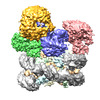
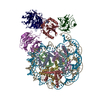
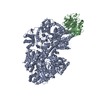

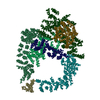
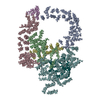







 Z (Sec.)
Z (Sec.) Y (Row.)
Y (Row.) X (Col.)
X (Col.)






































